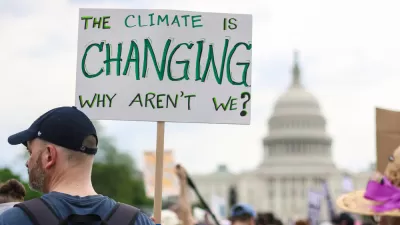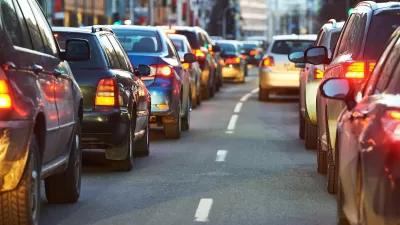In an earlier post, I discussed the difference between mobility, accessibility, and transportation technology. In today’s post, I want to discuss what I think is the next step in this taxonomy in terms of the implications for the built environment and urban planning. More specifically, we need to move beyond the idea that certain transportation technologies—whether it is a car, a bus, a train, or our feet—are substitutes.
In an earlier post, I discussed the difference between mobility, accessibility, and transportation technology. In today's post, I want to discuss what I think is the next step in this taxonomy in terms of the implications for the built environment and urban planning. More specifically, we need to move beyond the idea that certain transportation technologies-whether it is a car, a bus, a train, or our feet-are substitutes. The real question is ensuring the right transportation technologies are in the right place at the right time to maximize accessibility while maximizing mobility within a cost-effective framework with minimal public subsidy.
Our (transportation consumers') interest in accessing goods and services will determine to a large degree the transportation technologies we use. Thus, in Manhattan (population density = 71,000 people per square mile), the dominant mode of obtaining access to goods and services is by foot. Manhattan, as we point out in our book Mobility First (Chapter 4), is a walking city. Public transit is also important (mostly rail but also bus), but this technology is suitable for destinations outside the immediate neighborhood not reaching destinations within a couple (or even several) blocks. Cars simply don't make sense for both mobility and personal cost reasons in these high-density settings.
Across the East River, the transportation story is more complex. In Brooklyn (Population Density=35,000), choices of transportation technologies (also known as modes) are more evenly split between automobiles, public transit, and walking. In Queens (population density = 20,000), 60 percent of commuters travel by car. In Staten Island (population density = 7,500), 71 percent commute by car.
All this is rather academic, but the point is not the obvious one that the automobile is dominant in low-density settings. Rather, it's the transportation choice set changes depending on the character of the built environment. The danger is in thinking that transportation modes are perfect substitutes in terms of their ability to provide mobility and access in all urban settings. In short, adopting a blanket principle that communities benefit from have the greatest number of transportation choices is not necessarily true.
Ponder the following general rules of thumb. Automobiles are unquestionably the most flexible and adaptable, but they are neither the most popular not the most efficient choices for all settings. (Personal car trips make up less than 5 percent of all commuting trips in Manhattan, for example.) Cars, in low and medium-density settings are quite efficient for most people traveling distances of at least a mile or more (but less than several hundred). Walking, however, is quite effective for the vast majority of people for accessing destinations and points of less than a mile. It doesn't make sense (and most people don't) use the automobile to access services and goods with a few hundred feet or yards of where the live or work. (The exception, of course, is when safety might dictate the use of an alternative mode, whether walking or transit.) Bicycles, in the right context, provide an excellent point-to-point access for those traveling one to three miles. Public transit is typically most efficient for accessing destinations of three to ten miles as long as a direct route is available although the big downside to public transit is lack of point-to-point access to primary destinations and origins.
The kicker is that different built environments make different transportation modes relatively more (or less) effective and efficient (both in terms of social and private costs). Public transit simply can't provide meaningful alternatives for most people living and working in low-density suburban neighborhoods (with densities typically less than 5,000 people per square mile or less).
Since optimizing public transit is a fundamental value (perhaps even "objective" in the philosophical sense) for many professional planners, transportation policy proposals are almost always framed in the context of boosting public transit without a meaningful discussion of the implications for the built environment. The all too facile "answer" to low transit ridership is to densify neighborhoods to justify the expansion of transit, but this assumes that these higher densities will provide equivalent access to the services and goods people want.
This also implies a functional equivalency between built environments, as if, from a planning perspective, there is no meaningful lifestyle or quality of life difference between a Brooklyn-style neighborhood compared to a conventional suburban-style neighborhood (e.g., Staten Island). Yet, as any planner understands, these neighborhood styles are not functionally equivalent. As an empirical reality, households (in the U.S. or elsewhere) are not neutral with respect to their housing or neighborhood preferences.
Thus, when discussing mobility, accessibility and transportation technologies, planners should be cognizant of the reality that for most households moving to more dense, mixed use, Brooklyn-style neighborhoods-the ones that truly favor and optimize multimode transportation options-will also view this a dramatic shift in life style and quality of life. A functional and meaningful difference exists between living in a single-family home with a yard and an attached private garage versus a townhouse with curbside, open air parking and (optimistically) a sliver of personal open space. Similarly, a function and aesthetic difference exists between a three bedroom, two-bath ranch house and open floor plan, and a narrow, stacked row house with three bedrooms and two bathrooms. In most cases, travel times and the complexity of travel necessary to access goods and services will increase as well.
As I have mentioned previously, mobility is a normal economic good, which means the demand for greater mobility increases with income. Shifting households to neighborhoods that require alternative transportation modes that are more cumbersome, complex, and time intensive will require compensating urban amenities that offsets these disadvantages. Otherwise, society and communities suffer.

Alabama: Trump Terminates Settlements for Black Communities Harmed By Raw Sewage
Trump deemed the landmark civil rights agreement “illegal DEI and environmental justice policy.”

Planetizen Federal Action Tracker
A weekly monitor of how Trump’s orders and actions are impacting planners and planning in America.

The 120 Year Old Tiny Home Villages That Sheltered San Francisco’s Earthquake Refugees
More than a century ago, San Francisco mobilized to house thousands of residents displaced by the 1906 earthquake. Could their strategy offer a model for the present?

Housing Vouchers as a Key Piece of Houston’s Housing Strategy
The Houston Housing Authority supports 19,000 households through the housing voucher program.

Rural Population Grew Again in 2024
Americans continued to move to smaller towns and cities, resulting in a fourth straight year of growth in rural areas.

Safe Streets Grants: What to Know
This year’s round of Safe Streets for All grant criteria come with some changes.
Urban Design for Planners 1: Software Tools
This six-course series explores essential urban design concepts using open source software and equips planners with the tools they need to participate fully in the urban design process.
Planning for Universal Design
Learn the tools for implementing Universal Design in planning regulations.
Clanton & Associates, Inc.
Jessamine County Fiscal Court
Institute for Housing and Urban Development Studies (IHS)
City of Grandview
Harvard GSD Executive Education
Toledo-Lucas County Plan Commissions
Salt Lake City
NYU Wagner Graduate School of Public Service






























